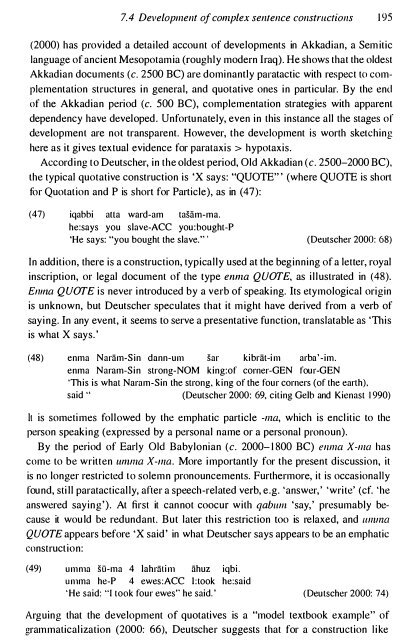Gram - SEAS
Gram - SEAS
Gram - SEAS
You also want an ePaper? Increase the reach of your titles
YUMPU automatically turns print PDFs into web optimized ePapers that Google loves.
7. 4 Development of complex sentence constructiolls 195<br />
(2000) has provided a detailed account of developments in Akkadian, a Semitic<br />
language of ancient Mesopotamia (roughly modern Iraq). He shows that the oldest<br />
Akkadian documents (c. 2500 BC) are dominantly pm'atactic with respect to complementation<br />
structures in general, and quotative ones in particular. By the end<br />
of the Akkadian period (c. 500 BC), complementation strategies with apparent<br />
dependency have developed. Unfortunately, even in this instance all the stages of<br />
development are not transparent. However, the development is worth sketching<br />
here as it gives textual evidence for parataxis > hypotaxis.<br />
According to Deutscher, in the oldest period, Old Akkadian (c. 2500-2000 BC),<br />
the typical quotative construction is 'X says: "QUOTE'" (where QUOTE is short<br />
fo r Quotation and P is short for Particle), as in (47):<br />
(47) iqabbi aUa ward-am tasam-ma.<br />
he:says you slave-ACC you:bought-P<br />
'He says: "you bought the slave.'" (Deutscher 2000: 68)<br />
In addition, there is a construction, typically used at the beginning of a letter, royal<br />
inscription, or legal document of the type enma QUOTE, as illustrated in (48).<br />
Ellllza QUOTE is never introduced by a verb of speaking. Its etymological origin<br />
is unknown, but Deutscher speculates that it might have derived from a verb of<br />
saying. In any event, it seems to serve a presentative fu nction, translatable as 'This<br />
is what X says.'<br />
(48) enma Naram-Sin dann-ulll sar kibrat-illl arba' -im.<br />
enma Naram-Sin strong-NOM king:of corner-GEN four-GEN<br />
This is what Naram-Sin the strong, king of the four corners (of the earth),<br />
said " (Deutscher 2000: 69, citing Gelb and Kienast 1990)<br />
It is sometimes followed by the emphatic particle -ma, which is enclitic to the<br />
person speaking (expressed by a personal name or a personal pronoun).<br />
By the period of Early Old Babylonian (c. 2000- 1800 BC) ellma X-lila has<br />
come to be written umma X-lila. More importantly for the present discussion, it<br />
is no longer restricted to solemn pronouncements. Furthermore, it is occasionally<br />
fou nd, still paratactically, after a speech-related verb, e.g. 'answer,' 'write' (cf. 'he<br />
answered saying'). At first it cannot coocur with qabulIl 'say,' presumably because<br />
it would be redundant. But later this restriction too is relaxed, and /./ /Iuna<br />
QUOTE appears before 'X said' in what Deutscher says appears to be an emphatic<br />
construction:<br />
(49) Ulllllla sO-ma 4 lahriililll ahuz iqbi.<br />
ulllma he-P 4 ewes:ACC I:took he:said<br />
'He said: ". took four ewes" he said.' (Deutscher 2000: 74)<br />
Arguing that the development of quotatives is a "model textbook example" of<br />
grammaticalization (2000: 66), Deutscher suggests that for a construction like
















